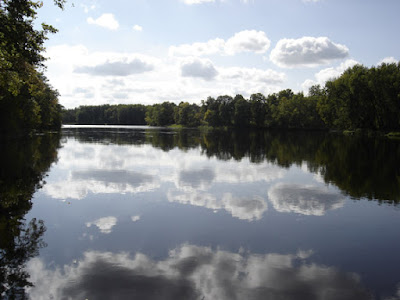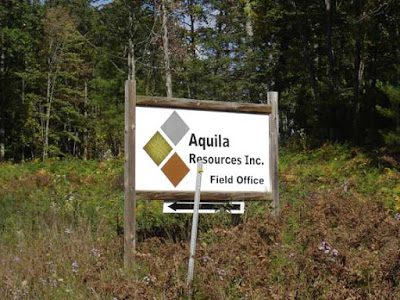Following the showing of the Peruvian documentary film Daughter of the Lake at Michigan Tech, Miguel Levy, Michigan Tech professor of physics and coordinator of the Indigenous Peoples' Day Campaign, a community group concerned about indigenous peoples' rights, invites the audience to ask questions of the film's director, Ernesto Cabellos, via Skype. (Photos by Keweenaw Now unless otherwise indicated.)
HOUGHTON -- Nélida -- an indigenous woman with a love for her Andean lakes, a belief in water spirits, and a desire to educate herself in the law in order to help her people -- joins a struggle against a gold mining company threatening her community's water: This true story told through the documentary film Daughter of the Lake (Hija de la Laguna) was screened recently at Michigan Tech by the Indigenous Peoples' Day Campaign, a local community group of Native and non-Native members concerned about indigenous peoples' rights.
Miguel Levy, Michigan Tech professor of physics and unofficial coordinator of the group, arranged the Sept. 20, 2017, screening of the film as well as a Skype communication with the Peruvian director, Ernesto Cabellos, to allow the local audience to ask questions of the director following the film. In addition, the group invited Ken Fish, a member of the Menominee Tribe in Wisconsin, who have been protesting a similar gold mining project -- Aquila Resources' proposed Back 40 project near the Menominee River -- to speak about his own experiences in fighting destructive extractive industries that threaten Native and non-Native communities.
"The film highlights the key role played by indigenous people, particularly women, in the protection of the environment and in opposition to the human and environmental costs of gold mining in the Peruvian Andes," Levy said. "The participation in this screening by Ken Fish from the Menominee tribe in Wisconsin, who are also facing the threat of contamination from gold mining of the Menominee River, highlights the commonality of interests of indigenous as well as non-indigenous people in this struggle."
Here Levy introduces the film, giving some background on the mining company in Peru and the indigenous resistance against their gold mining project:
Nélida Ayay Chilón, 31, the protagonist of the film, is from the community of Porcón (Cajamarca, Peru). She is a farmer and now an environmental leader too, in a land where mining companies have been working since 1992. Although she loves living in the countryside and taking care of her animals and crops, she had to move to the city of Cajamarca in order to attend the university. She’s currently studying law to defend herself and her community from the abuses caused by mining activity. Nélida is a surprisingly tough woman, who is determined to defend Mother Earth and Mother Water.
Nélida is pictured here beside an Andean lake that appears in the film. At one point in the film, she learns about innocent protesters who were killed in clashes with the police and places photos of them in the lake as an offering to Mother Water. Like other indigenous citizens in the Andes, her relationship with nature is sacred and respectful. (Photo courtesy Guarango Film and Video and Ernesto Cabellos)
According to the film, Nélida is able to communicate with nature’s spirits. She feels she is the daughter of the lakes that provide water to her village. But just beneath her lakes, Yanacocha, Latin America’s largest gold mining company, has discovered a deposit valued at billions of dollars. They have the Peruvian government’s support to mine it, even though it means drying out the lakes.
The indigenous farmers who fear losing their water not only have to confront the political and economic powers, but also the people in their communities who now depend on the small jobs the mine has given them. When Nélida joins the march from her homeland to Lima, the country’s capital, over a thousand kilometers away, she realizes she’s not alone. There are thousands of people who want to protect the Andean water sources.
The poster for the Sept. 20 showing of the film at Michigan Tech shows Nélida near her Andean home with flowers she offers to the spirits of the water. (Poster courtesy Indigenous Peoples' Day Campaign)
At one point in the film, addressing Mother Earth, Nélida says, "Mother Earth, you have gold inside you. Do you know why they take your gold out of you? To have reserves of ingots in their banks. You
can’t drink gold. You can’t eat gold. Now, blood is being spilt for this gold. If it is so useful to the big and powerful, make them take it out of their reserves and recycle it, but don’t let them destroy you anymore. If we take good care of you, you can feed us forever."
Máxima Acuña de Chaupe, a Peruvian subsistence farmer who lives beside Nélida’s lake, as Miguel Levy mentions in his introduction, is threatened and beaten by men hired by the mining company because she refuses to give up her land.
"It’s this greed for gold that makes them want to take my land away from me no matter what, even using force," Máxima says. "Well basically, they came into my territory with their guns, fully armed. Right after they had called me to tell me they were going to kill me. We want to denounce this and to ask for protection, because they won’t let us live here peacefully."
Ernesto Cabellos, director of the film, was born in Lima, Peru, in 1968. In 1994, he founded Guarango, a documentary filmmakers association. His award-winning films chronicle over 10 years of conflict between communities and mining companies in Peru. Ernesto's documentaries have been selected in more than 150 international film festivals, obtaining 35 awards and distinctions, and broadcast on international television channels.*
Following the screening of Daughter of the Lake, Ernesto spoke via Skype to the audience at Michigan Tech and welcomed questions on the film.
Local attorney Evan Dixon asked a question about the heroine Nélida's legal studies.
During the discussion, Gustavo Bourdieu asks Ernesto if Peru has any laws to protect the water.
Opposition to Back 40 gold mining project near Menominee River parallels struggle portrayed in film
Following the film screening, Ken Fish spoke about the importance of protecting the water from mining pollution -- and his Menominee Tribe's opposition to the Aquila Back 40 gold mining project, which is planned to be an open-pit sulfide mine located about 10 miles from Stephenson, Michigan, near the Menominee River and the Wisconsin border. The proposed mine could impact the quality of the river as well as archaeological sites -- including the origin place of the Menominee people, Native burial sites and prehistoric garden mounds.
Fish noted that, in addition to tribal groups, all but one Wisconsin county near the Back 40 mine site have issued resolutions opposing Aquila's Back 40 mining project. He also referred to the non-Native residents living near the Menominee River who have joined together to oppose the project.
On Sept. 19, 2017, Keweenaw Now visited Michigan residents Jim and Janet Voss, founding members of the Front 40 group that has been opposing the Back 40 gold mining project since 2003.**
Jim and Janet Voss, founding members of the Front 40 environmental group opposing the Back 40 gold mining project, are pictured here at their home, located on the Menominee River, not far from the projected mine site.
Jim and Janet, both retired teachers, built their retirement home on this peaceful spot, where they have lived for 32 years.
"We like it here," Jim said. "We don't want a mine here."
View of the Menominee River near the home of Jim and Janet Voss. (September 2017 photo by Keweenaw Now)
Sign indicating Aquila Resources Field Office, located near the projected mine site.
Despite much opposition to the Back 40 project expressed at public hearings and other events, the Michigan Department of Environmental Quality (MDEQ) has granted Aquila Resources a Part 632 mining permit (issued Dec. 28, 2016); an NPDES (National Pollutant Discharge Elimination System) permit (effective Apr. 5, 2017), which includes piping wastewater discharge to the Menominee River; and an Air Quality permit to install (issued Dec. 28, 2016). The project still needs a Wetlands and Inland Streams permit from MDEQ.***
Aquila intends to construct an 800-feet deep open pit mine adjacent to the river, with a cut-off wall (to limit the movement of groundwater) less than 100 feet from the river. In addition to mining activities, the Back Forty calls for on-site crushing, milling, and refining through the use of flotation, separation and the use of cyanide. Two different tailings basins will be constructed to contain the waste-rock slurry, or what the industry calls "mine slimes."***
Jim Voss pointed out the burial mounds and ridges marking prehistoric garden sites in the area.
"This must have been almost a paradise for the Native Americans," he said. "You had the river -- where you had sturgeon, otter, beaver, clams, crayfish and other fish. Then you had the garden beds where they raised corn and possibly beans and squash."
This ancestral burial mound is among the archaeological sites that could be impacted by the proposed Back 40 mine.
In addition to local governments' opposition to the Back 40 project, tribal governments that have passed resolutions against the mine include the Menominee Indian Tribe of Wisconsin, the Oneida Tribe of Wisconsin, the Bad River Ojibwe Tribe of Wisconsin, the Keweenaw Bay Indian Community of Michigan, the Pokagon Band of Potawatomi,the Saginaw Chippewa Tribe and the Chippewa Ottawa Resource Authority of Michigan. American Rivers, a national conservation organization has listed the Menominee River as one of the 10 most endangered rivers due to the threat from sulfide mining.****
Following the Dec. 28, 2016, MDEQ approval of the Part 632 mining permit, Menominee Tribal Chairwoman, Joan Delabreau, stated the following:
"The approved desecration of our ancestors’ burial sites is absolutely disgraceful. What’s more egregious is the fact that the State of Michigan is knowingly permitting a foreign company the right to destroy the water and environmental quality, which poses additional consequences for all within the Great Lakes Basin and demonstrates the continued incompetence of the Department. The Tribe will continue to fight for the protection of our ancestors and the water and environmental quality."*****
This photo of the Menominee River was taken near prehistoric garden sites located on State of Michigan land near the proposed mine site. Archaeologists have estimated the gardens date between 1100 and 1300 A.D.
Asked if he and his wife plan to stay even if Aquila receives all its permits, Jim Voss replied, "That's our plan. We don't plan on going anywhere."
Notes:
* The film Daughter of the Lake can be seen on Netflix, available to subscribers here.
** To learn about the Front 40 group click here.
*** For more information about the Back 40 mine and links to DEQ permitting so far, see the the Upper Peninsula Environmental Coalition's (UPEC's) Mining Action Group's Aquila Back 40 Facts.
**** See July 2017 Action Alert from the Mining Action Group (formerly Save the Wild U.P.)
***** Click here to read more about the Menominee Tribe's opposition to the Back 40 mining project. See also Keweenaw Now's Oct. 29, 2016, article by Horst Schmidt, "DEQ hearing on Aquila Back Forty mining project attracts hundreds; deadline for written comments is Nov. 3."









































































































































No comments:
Post a Comment